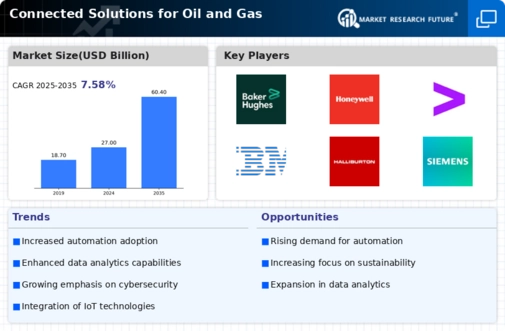Enhanced Operational Efficiency
The adoption of Connected Solutions for Oil and Gas Industry is primarily driven by the need for enhanced operational efficiency. Companies are increasingly leveraging advanced technologies to optimize their processes, reduce downtime, and improve productivity. For instance, the integration of real-time data analytics allows operators to monitor equipment performance continuously, leading to timely maintenance and reduced operational costs. According to recent data, organizations that implement connected solutions can achieve up to a 20% increase in operational efficiency. This trend is particularly evident in upstream operations, where the ability to analyze drilling data in real-time can significantly impact decision-making and resource allocation.
Regulatory Compliance and Safety
Regulatory compliance and safety considerations are pivotal drivers for the adoption of Connected Solutions for Oil and Gas Industry. As regulations become more stringent, companies are compelled to adopt technologies that ensure compliance with safety standards and environmental regulations. Connected solutions facilitate real-time monitoring of emissions and safety parameters, enabling companies to respond swiftly to potential hazards. Data indicates that organizations utilizing connected technologies can reduce safety incidents by approximately 30%. This not only protects personnel but also mitigates financial risks associated with non-compliance, making it a critical factor in the industry's technological evolution.
Growing Demand for Sustainability
The growing demand for sustainability is increasingly influencing the Connected Solutions for Oil and Gas Industry. Stakeholders, including consumers and investors, are placing greater emphasis on environmentally responsible practices. Connected solutions enable companies to monitor their environmental impact in real-time, facilitating compliance with sustainability goals. Data shows that firms adopting these technologies can reduce their carbon footprint by up to 25%. This shift towards sustainability not only enhances corporate reputation but also aligns with global trends towards cleaner energy, making it a crucial driver for the industry's future.
Advancements in Digital Technologies
Advancements in digital technologies serve as a significant driver for the Connected Solutions for Oil and Gas Industry. The rapid evolution of technologies such as artificial intelligence, machine learning, and the Internet of Things (IoT) has transformed how companies operate. These technologies facilitate the collection and analysis of vast amounts of data, enabling predictive maintenance and enhanced decision-making. For example, the use of AI algorithms can predict equipment failures before they occur, thereby reducing downtime. As these digital technologies continue to mature, their integration into the oil and gas sector is expected to accelerate, further driving the adoption of connected solutions.
Cost Reduction and Resource Optimization
Cost reduction and resource optimization are fundamental drivers for the Connected Solutions for Oil and Gas Industry. The volatile nature of oil prices necessitates that companies find innovative ways to cut costs while maximizing resource utilization. Connected solutions enable firms to analyze consumption patterns and identify inefficiencies, leading to more informed decision-making. Reports suggest that companies implementing these technologies can achieve cost savings of up to 15% through improved resource management. This focus on cost efficiency is particularly crucial in a competitive market, where maintaining profitability is increasingly challenging.

















Leave a Comment